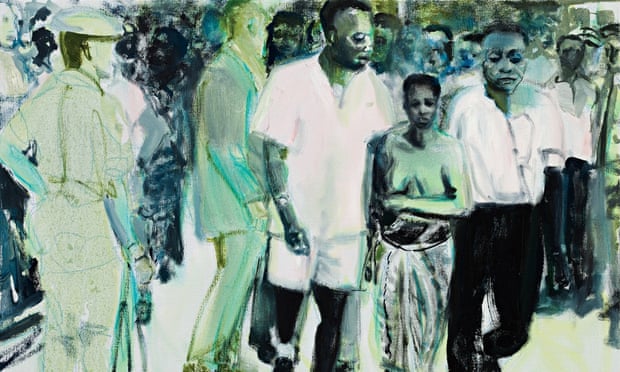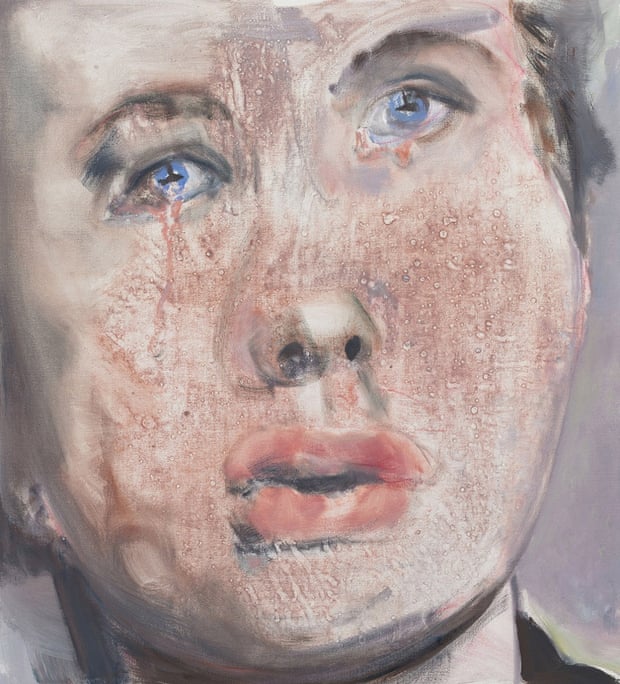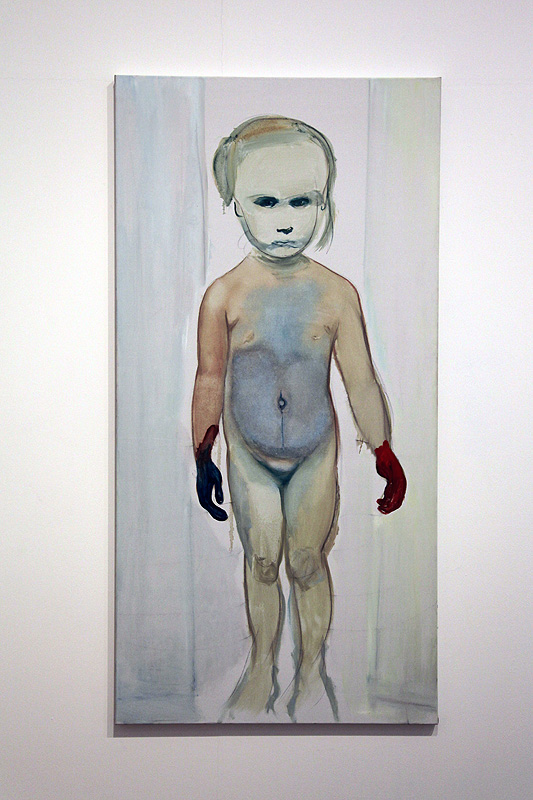 |
| Marlene Dumas, The Widow, 2013 |
I didn’t know Marlene Dumas’ fascinating
body of work at all. Tate Modern (together with the Stedelijk Museum in Amsterdam
and the Foundation Beyeler, Basel) have staged a wonderful exhibition of her
work to bring it to long overdue prominence in Europe. The work is politically challenging,
disturbing even, and aesthetically unusual.
The superb exhibition of the works is exemplified
by the space given them – their exhibition in the level four galleries makes
their discovery over time and through reflection possible. To give one example
of why the hanging seems very important to Dumas’ works, the pause between the diptych
in room 14 of two versions of The Widow, 2013
both reveals the narrative of Pauline Lumumba as she is led, bare breasted
through the streets of Léopoldville, surrounded by clothed men, their faces
whited out, following the assassination of her husband by the Katangan
authorities. Simultaneously, the two images are hung side by side to
demonstrate the repetition of a single event: the leading of Pauline Lumumba through
the streets of Léopoldville. And because the second painting is a closeup of
the first, it works as a cut that emphasizes the cinematic form of the narrative
Dumas represents. Across the cut we see an accompanying shift between public
and private experience of Lumumba the wife of the assassinated Prime Minister,
and Lumumba the woman grieving her husband’s death. Such a narrative is
confronting on so many levels: personally, politically, aesthetically.
 |
| Marlene Dumas, For Whom the Bell Tolls, 2008 |
Dumas’ work is so unique, that it’s
difficult to know how to approach it. Paintings, poetry, texts, photographs
filled with death, birth, life, violence, advertising and the movies, it
doesn’t look like anything I have in my image memory bank. That said I found
myself wanting to compare Dumas’ work to that of Luc Tuymans. Compositionally,
like Tuymans, Dumas crops faces and bodies, removes the location as context as
well as the mass cultural narrative from which the images are usually drawn.
Her painting like his, comes as a subtle use of cinematic repetitions, edits, closeups,
and spatial configurations. There is no depth to her images, the painting is
fast, superficial. This is what makes them of their time, like his, recognizeably
drawn from mass culture of the photographic age.
 |
| Marlene Dumas, The Painter, 1994 |
Unlike Tuymans however, her images are all
about women, and they are about the woman as an emotional, intimate individual
with an interior life. Access to that inner life may be denied, but we
recognize the representation of an individual subject, well before we
understand the public political face she wears. Tuymans’ figures on the other
hand are emotionally distant and placed first in the service of a
cultural/political narrative. Even in the paintings of a series such as the Magdelena we recognize Naomi Campbell,
Princess Diana and Venus, their representation as a discourse on race, class,
fame and fortune, each is more than the painted portrait on which Dumas draws
for inspiration. They are vulnerable, exposed, eroticized, and actively
confronting the desire of their image.
 |
| Marlene Dumas, The White Disease, 1985 |
Dumas’ vision of the body is fundamentally
a woman’s vision of the body: women’s bodies are seen, women are violated,
exposed, manipulated, and women confront the eye of the camera. A man could not
have painted these images without being accused of pornographic violation. But
a man would not want to paint these images because they are always in search of
an identity for women, women’s bodies. Even when she paints men's bodies. In the characteristic oscillation
between public and private, the women range from the most highly charged of
all—film stars and porn stars—through the most famous women in the history of
art, to those who should never be seen naked in public: her own daughter. And on her search for the identity of the
woman, Dumas finds death crisis, identity, oppression, the effect of injustice as
it has scarred the human body, the body as painting, the painting as body. These
recurring concerns make Dumas’ body of work frightening. And I kept thinking
that even though she moves to Amsterdam early enough in her life, every time we
turn and look at these women’s bodies, we see the racial injustice and violence
to the men and women of Dumas’ native South Africa.
 |
| Marlene Dumas, Magdalena (Out of Eggs, Out of Business), 1995 |
What makes Dumas’ work complex is that it
is always simultaneously about the identity of painting as well as the identity
of women. Dumas questions the status of the female body and at the same time
questions the status of the image. Throughout her body of work she consistently
makes this parallel enquiry but not through easy equation. She achieves the
parallel enquiry through her artistic vocabulary, as well as through the use
of the body in many different kinds of images, by male painters, porn stars,
stripper,s polaroids of her family, highly political imagery. The body is
deformed in and through the use of the watercolour or the paint, use of spray
paint that confuses boundaries, the blackened out eyes that continually
confront the viewer. There is something grotesque in the portrait images of
certain women, there is something grotesque in the repeated desire to represent
the bodies of women in images.
No comments:
Post a Comment